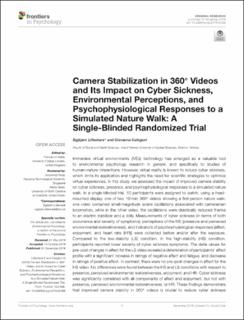| dc.description.abstract | Immersive virtual environments (IVEs) technology has emerged as a valuable tool to environmental psychology research in general, and specifically to studies of human–nature interactions. However, virtual reality is known to induce cyber sickness, which limits its application and highlights the need for scientific strategies to optimize virtual experiences. In this study, we assessed the impact of improved camera stability on cyber sickness, presence, and psychophysiological responses to a simulated nature walk. In a single-blinded trial, 50 participants were assigned to watch, using a head-mounted display, one of two 10-min 360° videos showing a first-person nature walk: one video contained small-magnitude scene oscillations associated with cameraman locomotion, while in the other video, the oscillations were drastically reduced thanks to an electric stabilizer and a dolly. Measurements of cyber sickness (in terms of both occurrence and severity of symptoms), perceptions of the IVE (presence and perceived environmental restorativeness), and indicators of psychophysiological responses [affect, enjoyment, and heart rate (HR)] were collected before and/or after the exposure. Compared to the low-stability (LS) condition, in the high-stability (HS) condition, participants reported lower severity of cyber sickness symptoms. The delta values for pre–post changes in affect for the LS video revealed a deterioration of participants’ affect profile with a significant increase in ratings of negative affect and fatigue, and decrease in ratings of positive affect. In contrast, there were no pre–post changes in affect for the HS video. No differences were found between the HS and LS conditions with respect to presence, perceived environmental restorativeness, enjoyment, and HR. Cyber sickness was significantly correlated with all components of affect and enjoyment, but not with presence, perceived environmental restorativeness, or HR. These findings demonstrate that improved camera stability in 360° videos is crucial to reduce cyber sickness symptoms and negative affective responses in IVE users. The lack of associations between improved stability and presence, perceived environmental restorativeness, and HR suggests that other aspects of IVE technology must be taken into account in order to improve virtual experiences of nature. | |
